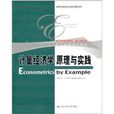《高等學校經濟類雙語教學推薦教材·經濟學經典教材·核心課系列:計量經濟學原理與實踐》是古扎拉蒂積數十年教學經驗、採用“乾中學”的方法組織教學材料編寫的計量經濟學教科書,沒有煩瑣複雜的理論推演和艱深的數學討論。《高等學校經濟類雙語教學推薦教材·經濟學經典教材·核心課系列:計量經濟學原理與實踐》從一個非常實用的角度解釋計量經濟學,每一章都由一到兩個活生生的案例來展開教學。每一個主題背後的基本理論均得到涵蓋,基礎的統計學概念在附錄中給出,這都使得《高等學校經濟類雙語教學推薦教材·經濟學經典教材·核心課系列:計量經濟學原理與實踐》不但結構靈活而且內容豐富。《高等學校經濟類雙語教學推薦教材·經濟學經典教材·核心課系列:計量經濟學原理與實踐》是計量經濟學初學者的首選佳作。
基本介紹
- 書名:高等學校經濟類雙語教學推薦教材•經濟學經典教材•核心課系列:計量經濟學原理與實踐
- 作者:達摩達爾·古扎拉蒂 (Damodar Gujarati)
- 出版日期:2013年1月1日
- 語種:英語, 簡體中文
- ISBN:9787300169910
- 品牌:中國人民大學出版社
- 外文名:Econometrics by Example
- 出版社:中國人民大學出版社
- 頁數:385頁
- 開本:16
- 定價:48.00
基本介紹,內容簡介,作者簡介,圖書目錄,文摘,
基本介紹
內容簡介
《高等學校經濟類雙語教學推薦教材·經濟學經典教材·核心課系列:計量經濟學原理與實踐》全部為國外知名出版公司的優秀教材,涵蓋了經濟類專業的所有主要課程。《高等學校經濟類雙語教學推薦教材·經濟學經典教材·核心課系列:計量經濟學原理與實踐》依據國內實際教學需要以及廣泛的適應性,部分對原版教材進行了全文影印,部分在保持原版教材體系結構和內容特色的基礎上進行了適當刪減。《高等學校經濟類雙語教學推薦教材·經濟學經典教材·核心課系列:計量經濟學原理與實踐》在原著選擇上緊扣國外教學前沿,基本上都是國外最流行教材的最新版本。《高等學校經濟類雙語教學推薦教材·經濟學經典教材·核心課系列:計量經濟學原理與實踐》一方面在內容和篇幅上很好地適應了國內雙語教學的實際需要,另一方面,低定價策略又避免了國外原版圖書高額的購買費用。
作者簡介
作者:(美國)達摩達爾·古扎拉蒂(Damodar Gujarati)
達摩達爾·古扎拉蒂(Damodar Gujarati),美國西點軍校經濟學榮休教授。他曾在紐約城市大學執教達25之久,之後又在紐約美國西點軍校政治科學系執教17年。古扎拉蒂在美國及世界知名的學術期刊上發表了大量的論文,這些期刊包括《經濟學與統計學評論》(Review of Economics and Statistics)、《經濟學雜誌》(Economic Journal)、《金融與數量分析雜誌》(Journal of Finance and Quantitative Analysis)和《商學雜誌》(Journal of Business)等。他的《計量經濟學基礎》是全球最流行的計量經濟學教材之一。
達摩達爾·古扎拉蒂(Damodar Gujarati),美國西點軍校經濟學榮休教授。他曾在紐約城市大學執教達25之久,之後又在紐約美國西點軍校政治科學系執教17年。古扎拉蒂在美國及世界知名的學術期刊上發表了大量的論文,這些期刊包括《經濟學與統計學評論》(Review of Economics and Statistics)、《經濟學雜誌》(Economic Journal)、《金融與數量分析雜誌》(Journal of Finance and Quantitative Analysis)和《商學雜誌》(Journal of Business)等。他的《計量經濟學基礎》是全球最流行的計量經濟學教材之一。
圖書目錄
前言
致謝
來自作者的提示
表目錄
圖目錄
第一部分 線性回歸模型
第1章 線性回歸模型:一個概覽
章2章 回歸模型的函式形式
第3章 定性解釋變數回歸模型
第二部分 經典線性回歸模型的重要評估
第4章 回歸診斷Ⅰ:多重共線性
第5章 回歸診斷Ⅱ:異方差性
第6章 回歸診斷Ⅲ:自相關
第7章 回歸診斷Ⅳ:模型設定錯誤
第三部分 橫截面數據回歸模型
第8章 logit和probit模型
第9章 多項回歸模型
第10章 序數回歸模型
第11章 限值因變數回歸模型
第12章 對計數數據建模:泊松和負二項回歸模型
第四部分 時間序列計量經濟學論題
第13章 平穩和非平穩時間序列
第14章 協積和誤差校正模型
第15章 資產價格波動性:arch和garch模型
第16章 經濟預測
第17章 面板數據回歸模型
第18章 生存分析
第19章 隨機回歸元和工具變數方法
簡要目錄 計量經濟學原理與實踐
附錄1 文中使用的數據集
附錄2 統計學附錄
索引
致謝
來自作者的提示
表目錄
圖目錄
第一部分 線性回歸模型
第1章 線性回歸模型:一個概覽
章2章 回歸模型的函式形式
第3章 定性解釋變數回歸模型
第二部分 經典線性回歸模型的重要評估
第4章 回歸診斷Ⅰ:多重共線性
第5章 回歸診斷Ⅱ:異方差性
第6章 回歸診斷Ⅲ:自相關
第7章 回歸診斷Ⅳ:模型設定錯誤
第三部分 橫截面數據回歸模型
第8章 logit和probit模型
第9章 多項回歸模型
第10章 序數回歸模型
第11章 限值因變數回歸模型
第12章 對計數數據建模:泊松和負二項回歸模型
第四部分 時間序列計量經濟學論題
第13章 平穩和非平穩時間序列
第14章 協積和誤差校正模型
第15章 資產價格波動性:arch和garch模型
第16章 經濟預測
第17章 面板數據回歸模型
第18章 生存分析
第19章 隨機回歸元和工具變數方法
簡要目錄 計量經濟學原理與實踐
附錄1 文中使用的數據集
附錄2 統計學附錄
索引
文摘
著作權頁:
In this chapter we considered a variety oflinear regression models-that is, models that are linear in the parameters or can be made linear with suitable transformations.Each modelis useful in speciric situations.In some applications more than one model may fit the data.We discussed the unique features of each modelin terms of slope and elasticity coefficients.
In comparing two or more models on the basis of R2 we pointed out that the dependent variable in these models must be the same.In particular, we discussed the choice between a linear and a log-linear model, two of the commonly used models in research.
Although we have discussed the various models in terms of two-variable or three-variable linear regression models for expository purposes, they can be easily extended to regression models involving any number of regressors,25 We can also have models in which some regressors are linear and some are log-linear.
We briefly discussed the role of standardized variables in regression analysis.Since a standardized variable has zero mean and unit standard deviation, it is easier to compare the relative influence of various regressors on the regressand.
We can evaluate a model in terms of the expected signs of the regression coefficients, their statistical significance in terms of the t value of the coefficients, or the F test if we are interested in the joint significance of two or more variables.We can judge the overall performance of a modelin terms ofR2.Ifwe are comparing two or more regression models, we can use the adjusted R2 or the Akaike or Schwarz information criteria.
In this chapter we also discussed how we can incorporate linear restrictions in estimating regression models.Such restrictions are often suggested by economic theory.
In this chapter we considered a variety oflinear regression models-that is, models that are linear in the parameters or can be made linear with suitable transformations.Each modelis useful in speciric situations.In some applications more than one model may fit the data.We discussed the unique features of each modelin terms of slope and elasticity coefficients.
In comparing two or more models on the basis of R2 we pointed out that the dependent variable in these models must be the same.In particular, we discussed the choice between a linear and a log-linear model, two of the commonly used models in research.
Although we have discussed the various models in terms of two-variable or three-variable linear regression models for expository purposes, they can be easily extended to regression models involving any number of regressors,25 We can also have models in which some regressors are linear and some are log-linear.
We briefly discussed the role of standardized variables in regression analysis.Since a standardized variable has zero mean and unit standard deviation, it is easier to compare the relative influence of various regressors on the regressand.
We can evaluate a model in terms of the expected signs of the regression coefficients, their statistical significance in terms of the t value of the coefficients, or the F test if we are interested in the joint significance of two or more variables.We can judge the overall performance of a modelin terms ofR2.Ifwe are comparing two or more regression models, we can use the adjusted R2 or the Akaike or Schwarz information criteria.
In this chapter we also discussed how we can incorporate linear restrictions in estimating regression models.Such restrictions are often suggested by economic theory.

